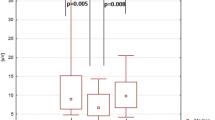We recorded visual evoked potentials (VEPs) in children suffering from medium and high myopia (3.0 to 6.0 and more than 6.0 D; 28 and 21 patients, respectively); a light flash was used as the stimulus. The VEPs were recorded before and after a curative course of phosphene electrostimulation (PhES; frequency 15 sec−1, 10 to 15 10-min-long everyday sessions). The above course resulted in clear trends toward decreases in the peak latencies of the P60 and P100 VEP components; changes in the latencies of other components were expressed to a lesser extent. In children with medium myopia, the latency of the P60 component decreased, on average, by more than 21% (P < 0.05); in patients with high myopia, the respective decrease was about 12% (P > 0.05). These shifts were accompanied by increases in the mean amplitudes of the P60 and, to a lesser degree, P100 (more expressed in medium myopia). The data obtained allow us to suppose that the PhES course provides increases in the transmission velocity through relay structures of the visual analyzer and in neuronal networks of the visual cortex and also in the number of neuronal units whose activity is reflected in generation of VEPs. Application of the PhES technique is much more effective in relatively moderate myopia.
Similar content being viewed by others
References
G. I. Nemtseev, V. B. Polyanskii, and G. L. Ruderman, “Functional results of treatment of patients with partial atrophy of the visual nerve using transcutaneous stimulation of the visual pathway,” in: Problems of Neurocybernetics [in Russian], Publishing House of the Rostov State Uviv., Rostov-on-Don (1989), pp. 11–312.
E. B. Companeyets, Neurophysiological Bases of Improvement and Recovery of the Functions of the Sensory Systems [in Russian], Abstr. of Doctoral Thesis, Biol. Sci., Moscow (1992).
V. S. Ponomarchouk, S. B. Slobodyanik, V. S. Drozhenko, et al., “Comparative analysis of the efficiency of phosphene electrostimulation in different ophthalmopathologies,” in: Urgent Problems of Ophthalmology [in Russian], Zaporozh'ye (1997), pp. 17–21.
T. V. Degtyarenko, V. S. Ponomarchouk, and A. G. Chaura, “Dependence of the curative effects of phosphene electrostimulation on its frequency in patients with myopia,” Neurophysiology, 34, No. 6, 431–435 (2002).
L. Ciganek, “The EEG response (evoked potential) to light stimulus in man,” Electroencephalogr. Clin. Neurophysiol., 13, No. 2, 165–172 (1961).
R. A. Hull, “Peak identification in visual evoked potentials,” Psychophysiology, 10, No. 1, 52–61 (1973).
E. C. Beck and R. E. Dustman, “Developmental electrophysiology of brain function as reflected by changes in the evoked response,” in: Brain Function and Maturation: Neuropsychological Methods of Assessment, John Wiley and Sons, New York (1975), pp. 325–388.
T. Allison, Y. Matsumia, G. D. Goff, and W. R. Goff, “The scalp topography of human visual evoked potentials,” Electroencephalogr. Clin. Neurophysiol., 42, No. 2, 185–197 (1977).
É. M. Routman, Evoked Potentials in Psychology and Psychophysiology [in Russian], Nauka, Moscow (1979).
A. M. Halliday, Standards for Clinical Practice of EP Recording in Recommendations of International EEG Society and Clinical Neurophysiologists, Elsevier, Amsterdam (1983).
A. Kubatko-Zelinska, K. M. Krzystova, and J. Lebiedz, “The pattern of visual evoked potentials in treatment of amblyopia in children,” in: Advances in Strabismology, G. Lennerstrand (ed.), Aeolus Press (1999), pp. 37–40.
V. V. Gnezditskii and A. M. Shampinova, Experience of Application of Evoked Potentials in Clinical Practice [in Russian], Sci.-Med. Co. MBN, Moscow (2001).
Author information
Authors and Affiliations
Corresponding author
Additional information
Neirofiziologiya/Neurophysiology, Vol. 40, No. 3, pp. 228–235, May–June, 2008.
Rights and permissions
About this article
Cite this article
Degtyarenko, T.V., Boichouk, I.M. & Chaura, A.G. Changes in visual evoked potentials after phosphene electrostimulation in children suffering from myopia. Neurophysiology 40, 193–198 (2008). https://doi.org/10.1007/s11062-008-9032-5
Received:
Published:
Issue Date:
DOI: https://doi.org/10.1007/s11062-008-9032-5



